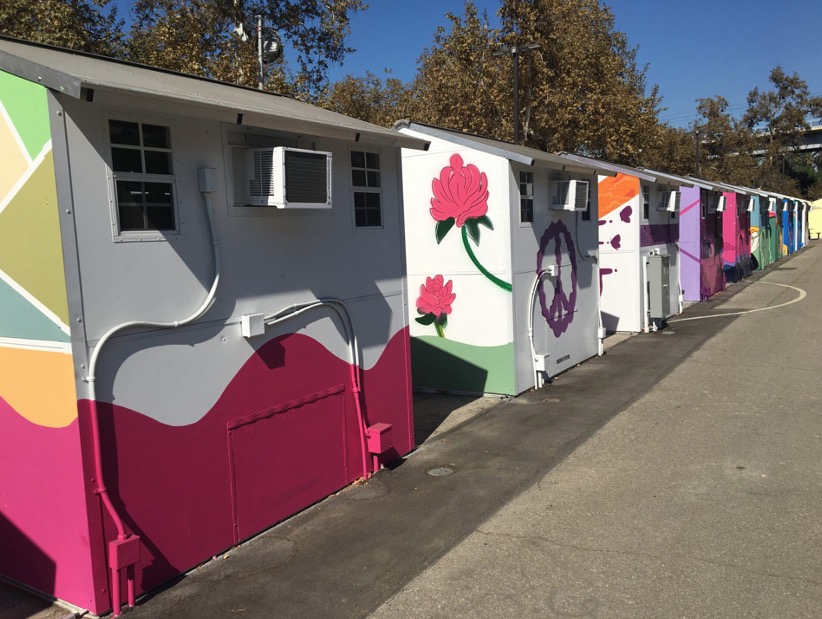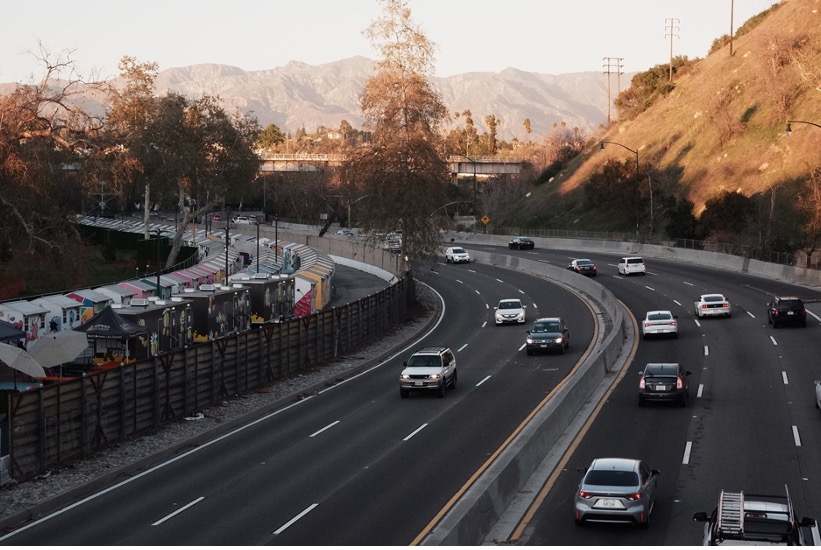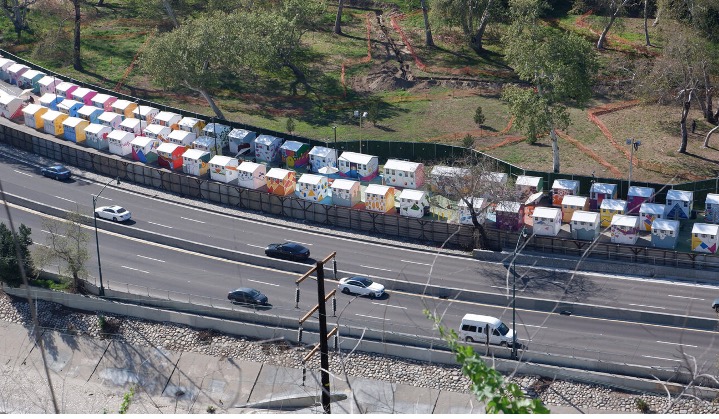CommentsHOUSING CRISIS - Under the guise of housing, LA’s tiny home villages serve to contain and banish unhoused people.
On a long weekend in October of 2021, I gathered with a small group of people on the hot asphalt of a former access road surrounded by an 8-foot tall fence. We stood among 117 prefabricated sheds that had been installed on the site, each smaller than a 70-square foot (6.5 m2) prison cell—the minimum recommended by the American Correctional Association. Directly to our east was a freeway, and to our west was a park, little-used due to noise and pollution. Over the top of the fence, we could see a hornet’s nest hanging from one of the trees closest to the camp.
We were at the open house of a new “Tiny Home Village” in the rapidly-gentrifying neighborhood of Highland Park, funded and built in the summer of 2021 by the City of Los Angeles and operated by Christian nonprofit Hope of the Valley (HOTV). The stated purpose of the sheds was temporary housing for 224 tenants transitioning out of houselessness. Our guide at the open house was the founder and CEO of HOTV, Ken Craft. Once we found a place to hide from the sun in the shadow of one of the sheds, Craft began the tour with a reassurance: “Do you folks know what makes all of this work? It’s this gate right here,” he said, pointing at the only gate along the perimeter fence, “and these cameras up here,” he said, boasting about the surveillance cameras mounted on the floodlights along the site’s main axis.
Each shed is 64 square feet (just under 6 m2), enclosed by fiberglass reinforced plastic panels on an aluminum frame, manufactured in Seattle by Pallet Shelter. Each shed has two beds, shelving, and an air conditioning unit. The bathrooms and laundry room are shared. Residents aren’t allowed to cook—instead, they’re served three meals a day. The sheds stand 10 feet apart in rows facing walkways that pierce the site from end to end. Where the site’s boundaries curve, a bend in the walkway interrupts the tunnel effect of the sheds’ repetitive forms.

The tiny sheds at the Arroyo Seco Tiny Home Village are painted with murals by the winner of a YouTube Originals
competition called “Instant Influencer.”
This was the sixth camp of its kind to open in LA since 2021, and the largest in the nation. US Cities have been constructing tiny home villages since 2016, when the International Residential Code was appended to include tiny homes. These tiny shed camps are filling up leftover parcels of public land across the city, particularly in gentrifying neighborhoods. In an effort to disguise their resemblance to internment camps, some of the camps are dressed up with garish supergraphics on the asphalt, or saccharine murals of hearts and gummy bears painted on the sheds. No amount of whimsy can domesticate the harsh environment produced by rows of sheds designed to be as cheap and as fast to install as possible. But the defining features of these camps are the most invisible: the dehumanizing rules that tenants have to live by. Tiny home villages masquerade as housing but are carceral in nature.
On our tour, Craft described some of the rules that govern life at the camp: every time tenants come back to the camp, they’re searched by security guards. Anyone who misses the 10PM curfew is locked out for the night. Outside guests aren’t allowed at any time but staff conduct “wellness checks” three times a day, violating tenants’ privacy. I spoke to several members of the grassroots organization Street Watch LA (SWLA) as well as tenants at tiny shed camps, who elaborated key rules: tenants aren’t allowed to be gone for over 48 hours, can only bring two 16-gallon bags of personal belongings with them, and aren’t given a key. Michael, a tenant at the “Village for Vets” tiny shed camp on the West LA Veterans Affairs campus, has been demanding that staff provide tenants with keys and was fed up with the contradictions: “They’re trying to find me housing but they don’t trust me with a fucking key?”
These rules are enforced, and sometimes changed, at the staff’s discretion. Residents and advocates describe the staff as underpaid and underqualified, themselves struggling to maintain their housing but lacking solidarity with the tenants of the tiny sheds where they work. Bunny, a mutual aid organizer for the residents at the “Salvation Village” tiny shed camp, said that staff had stopped providing residents with cleaning products, but continue to do cleanliness checks. When Bunny bought the residents cleaning products, the staff wouldn’t allow residents to store the supplies in any one place where they could be shared, preventing residents from cleaning their sheds to the staff’s standards.
Designed as emergency shelters, the sheds fail to support daily life. When they aren’t flooding from the rain, morning dew comes in through the walls, soaking papers and documents. The heaters are hard to control and have been known to make the concrete floors so hot that people have burned their feet getting out of bed.
Residents endure these conditions because they’re afraid of being deemed “housing-resistant” and de-prioritized for permanent housing. Meanwhile, people get evicted from the sheds without due process. A mother and daughter were evicted for staying with the girl’s father for three consecutive days, and a pregnant woman was told that once she gives birth she’ll have to move out. The nonprofits that administer the tiny shed camps estimate a period of between three and six months between moving into a tiny shed and getting permanent housing, but of the people I interviewed, no one had heard of anyone entering directly into permanent housing from a tiny shed. Some tenants who have put community pressure on their caseworkers have received Section 8 vouchers, which use government funds to subsidize rents paid to private landlords but do not guarantee that a landlord will accept the voucher.
Tiny sheds must be understood not as homes or as housing, but as an architecture of containment and banishment. A home is a place where you can feel comfortable and secure, where you can fulfill your basic needs without being monitored and leave to visit loved ones without fearing losing your home. Many tiny shed residents maintain a place outside because that’s where their community is, or what they can call home. I spoke to Carly O., a member of SWLA and the LA Tenants Union (LATU), who described the way that tiny homes are used to redefine “home” in order to cater to people who have never been homeless: “They’ve engineered the perfect concept of housing for NIMBYs (Not in my Backyard). This is not meant for the people who are going to be forced to accept these things—it’s meant for the people that want homeless people to disappear.”
Rick Vansleve, president of HOTV, described the camps’ impact on their surrounding neighborhood: “…People in the neighborhood see less homeless, less trash, less crime, fewer drug users roaming around. I think these villages should spread across the country like Starbucks—be in every community.” The role of the tiny shed camp in a comprehensive gentrification plan is clear. Tiny sheds and other forms of carceral housing are part of a system of interdependent measures intended to banish unhoused people from the public eye and to invisible the poverty produced by high rents and low wages. Among these measures are sit/lie laws which criminalize unhoused people who sit or lie in public space. Squalor*, an unhoused member of SWLA and LATU told me, “The city has two buttons. Button one: ‘conform’. Button two: ‘go to jail’. If you don’t conform, press button two, go to jail, and that’s the tiny sheds.” US cities have a long tradition of rebranding laws that banish poor, queer, disabled, and racialized people.
Criminalization is at the heart of LA’s homeless services system. LA Municipal Code 41.18, a sit/lie law which has been struck down and revived many times since its inception in 1967, can be traced to post-Civil War black codes, the vagrancy laws of the early 20th century, and the policing of the borders of redlined neighborhoods in the mid-20th century. In the fall of 2021, 41.18 was reincarnated as the business lobby lusted for the return of tourists, city councilors threw in their bids for the mayoral race, and the 2028 Summer Olympics Games drew closer. The current iteration of 41.18 bans people from sitting or lying within a territory of “special enforcement zones” delineated through invisible circles drawn around pieces of infrastructure, street furniture, types of public spaces and types of buildings. The circles vary in size, from 2-foot to 1000-foot diameters. Every homeless shelter and service provider has a 1000-foot circle around it. With every new tiny shed camp comes a new special enforcement zone. City councilors can also now draw these zones at their whim, typically targeting existing encampments. This invisible territory is difficult to predict and guaranteed to be unknown in its entirety by the very people it targets.
City agencies have promised to foreground housing placements ahead of the enforcement of this ordinance through encampment evictions. So far, unhoused people have noted an absence of outreach before sanitation workers arrive to destroy their property. Instead, armed law enforcement officers surround them while city workers tell them to go to a shelter. Among the flaws in this equation is the dead-end: the lack of permanent—or even temporary—housing available to poor people. Instead, officials coerce people into carceral housing programs that are constantly at capacity: tiny shed camps, hotel rooms with rules and curfews, and congregate shelters that kick people out in the morning.

An undesirable parcel of public land along the 110 Freeway houses a tiny shed camp.
A recent report from UCLA’s Institute on Inequality indicates that a stay in temporary housing can be harmful to people’s physical, mental, and social health. The report links deaths during or after a stay in carceral housing to a number of factors, from the relentless constriction of daily life by draconian regulations, to the isolation residents feel within their atomized rooms, and the strict rules that force drug users to use in unsafe, isolated conditions. When people exit temporary housing and return to their encampment, they often find that their community has been swept away, causing further trauma. When considered to be housing, it’s unclear why these programs don’t add up to a decrease in homelessness. But when these hotel rooms, sheds, and dorms are seen for what they are—the architectural expressions of policies that invisible poverty while doing little to help people out of it, land use interventions that justify the banishment of unhoused people from gentrifying neighborhoods, and an extension of the carceral state into the home—the equation crystallizes into a cruel formula for circumscribing the lives of unhoused people.
Understanding that permanent housing exists almost exclusively for those who can afford to pay high rents, some unhoused people and their allies have started building tiny shelters themselves. In early 2021, a Toronto carpenter named Khaleel Seivwright built tiny shelters and delivered them to unhoused people in the public places where they lived. The City of Toronto filed a restraining order against him to prevent him from this life-saving work. A similar story unfolded in LA, where Elvis Summers was barred from delivering tiny shelters to people living on the streets in Compton. These self-built tiny sheds give residents security and protection from the elements without destroying their community or disrupting their lives.
Tiny sheds are damaging to the organized demands of unhoused people. They demonstrate the societal failure to imagine a comfortable, safe, and dignified apartment as the site where homelessness ends, while normalizing the presumption that an inability to pay rent or mortgage makes a person subhuman. Instead of supporting the self-determination of unhoused people by providing bathrooms and waste pickup at existing encampments, the city’s homeless services system disempowers them, invoking right-wing “country of laws” rhetoric and subjecting them to rules that no housed person has to live by. Instead of public housing, dehumanizing sheds are built to warehouse poor people out of sight, and an ecosystem of policies work to jail and erase those who refuse to be warehoused. The members of Unhoused Tenants Against Carceral Housing, a grassroots group in LA, have put forth their demands: the de-carceration of temporary housing; and “community self-determination, autonomy, and the same rights as housed tenants in Los Angeles”. According to the 2020 Greater LA homeless count, nearly 60 percent of unhoused Angelenos cite economic hardship as the cause of their houselessness. The long-term prevention of houselessness demands the end of evictions and the socialization of housing, rather than the banishment of the poor—and the solution to houselessness now is a permanent home, not a cage.
*Squalor’s name has been altered at their request.
(Sasha Plotnikova is a critic and designer living in Los Angeles. She is a contributing editor at Uneven Earth and teaches at Cal Poly Pomona. Her work is concerned with the relationship communities have with their built environment, and how they respond when capitalist property relations get in their way.)
















